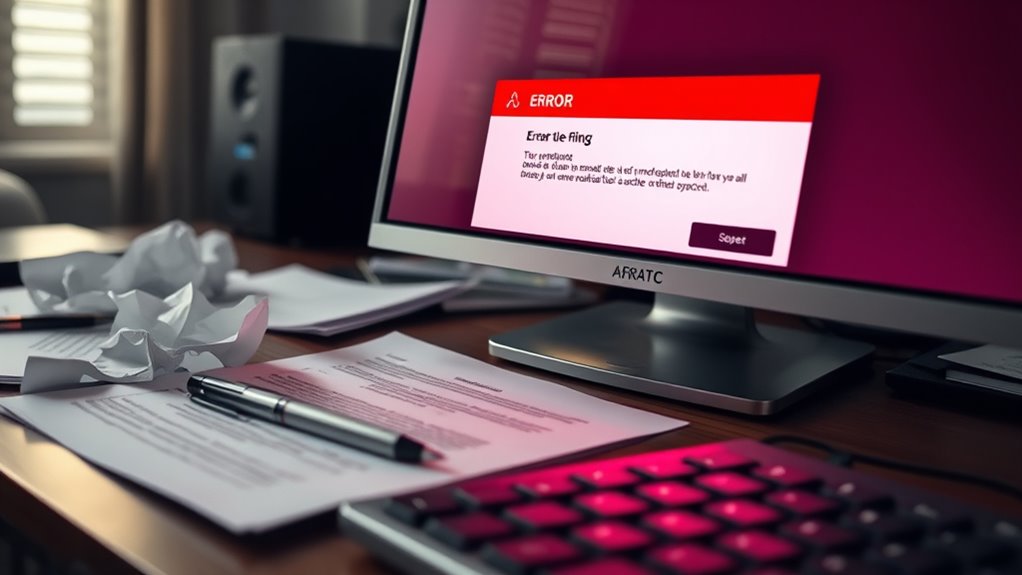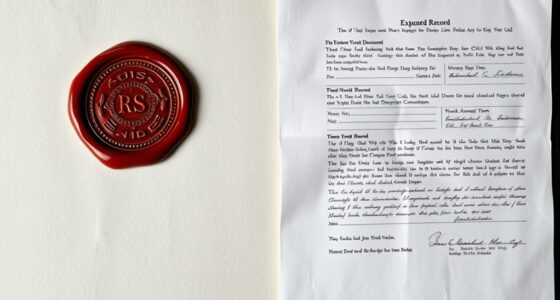When e-filing, errors like submitting incomplete documents, entering incorrect case details, or mistyping personal information can cause your case to be rejected or thrown out. Common mistakes include mismatched Social Security numbers, missing supporting evidence, or using incompatible files. Failing to double-check your entries or follow instructions can also lead to rejection. Stay alert to avoid these pitfalls, and if you keep exploring, you’ll discover how to guard against these mistakes effectively.
Key Takeaways
- Providing incorrect or inconsistent personal information can cause your case to be rejected.
- Submitting incomplete documentation or missing required forms leads to case dismissal.
- Errors in data entry or miscalculations can invalidate your filing.
- Failing to follow submission instructions or selecting the wrong form results in rejection.
- Using poor-quality or incompatible files without verification may cause your case to be thrown out.

Have you ever wondered why your e-filing returns get rejected or delayed? The answer often lies in common pitfalls and filing mistakes that many filers unknowingly make. These errors can be simple oversights but can also have serious consequences, including your case being thrown out or facing penalties. Understanding these common errors is key to ensuring your filings go smoothly and are accepted without issue.
One of the most frequent pitfalls is entering incorrect or inconsistent information. This might mean mismatched Social Security numbers, misspelled names, or incorrect addresses. Even small discrepancies can trigger rejection notices from the system, forcing you to redo the process and risking delays. Double-check all personal and case-related information before submitting. Take the time to verify each detail matches official records to prevent unnecessary rejections.
Another common filing mistake is incomplete or missing documentation. E-filing systems typically require all necessary forms, attachments, and supporting evidence to be uploaded correctly. Forgetting to attach a crucial document or leaving a section blank can cause your submission to be flagged or rejected outright. Make a checklist of all required materials and review it thoroughly before submitting to ensure nothing is overlooked.
Errors in calculations or data entry also cause headaches. Many e-filing platforms automatically perform some calculations, but if you’ve entered numbers incorrectly, it can lead to mismatched totals or invalid entries. Always review your inputs carefully. Use built-in validation tools if available, and avoid rushing through the process. Mistakes in data entry might seem minor, but they can invalidate your entire filing, leading to delays or even case dismissal.
User errors during the submission process are another common issue. This includes selecting the wrong form, submitting to the incorrect jurisdiction, or failing to follow specific instructions provided by the court or agency. Read all instructions carefully before submitting, and make sure you select the appropriate options. If you’re unsure about any step, consult the guidelines or seek assistance to avoid costly mistakes.
Additionally, selecting the proper juice extraction methods when preparing supporting documents, such as forms or evidence, can help prevent technical issues during submission. Properly formatted and clear documents reduce the likelihood of rejection due to file incompatibility or poor quality.
Lastly, neglecting to keep copies of your submissions and confirmation receipts can create problems later. Always save a copy of your filed return and the confirmation email or receipt. This documentation can be vital if your case faces delays or disputes, providing proof of timely and accurate submission.
Frequently Asked Questions
How Can I Prevent E-Filing Errors Before Submitting?
To prevent e-filing errors before submitting, you should use detailed filing checklists to guarantee all information is correct and complete. Attending training seminars can also boost your understanding of the process and highlight common pitfalls. Double-check your entries, verify all attachments, and review everything carefully before hitting submit. These steps help avoid mistakes that could delay your case or cause it to be thrown out.
What Should I Do if My E-File Is Rejected?
If your e-file gets rejected, you should carefully review the rejection notice for specific issues. Make sure you meet the e-filing deadlines and address any errors promptly. Double-check for privacy concerns, such as sensitive information, before resubmitting. Contact the court or e-filing support if you’re unsure about the reason for rejection. Acting quickly helps guarantee your case stays on track and avoids missing critical deadlines.
Are There Software Tools to Check for E-Filing Mistakes?
Thinking about software tools is like having a safety net for your e-filing process. You can use error detection tools and software validation features to catch mistakes early. These tools automatically scan your documents for common errors, ensuring your submission is accurate and complete before you submit. They’re designed to save you time, reduce frustration, and increase the chances your e-file gets accepted on the first try.
How Do Courts Handle Repeated E-Filing Errors?
When you make repeated e-filing errors, courts often respond with sanctions to enforce proper procedures. They may require error correction and impose penalties to discourage mistakes. If you keep submitting flawed filings, expect stricter oversight and possible delays. Courts want accurate, timely submissions, so it’s vital to review your filings carefully and address errors promptly to avoid sanctions and guarantee your case proceeds smoothly.
Can E-Filing Errors Impact My Case Timeline?
Yes, e-filing errors can impact your case timeline. If you miss filing deadlines or submit documents without proper electronic signatures, your case could face delays. Courts expect timely submissions, so errors like improper electronic signatures or late filings may result in rescheduling hearings or dismissals. To avoid this, double-check that all documents are signed electronically and submitted before deadlines to keep your case moving smoothly.
Conclusion
Avoiding e-filing errors is like steering clear of rocky waters—you don’t want your case to hit a rough patch and get thrown out. Double-check every detail, follow the guidelines, and stay attentive. Remember, a small mistake today can turn into a big obstacle tomorrow. Stay vigilant and precise, so your case sails smoothly through the digital tide, rather than crashing on the rocks of rejection. Keep your filings flawless and your legal journey steady.









